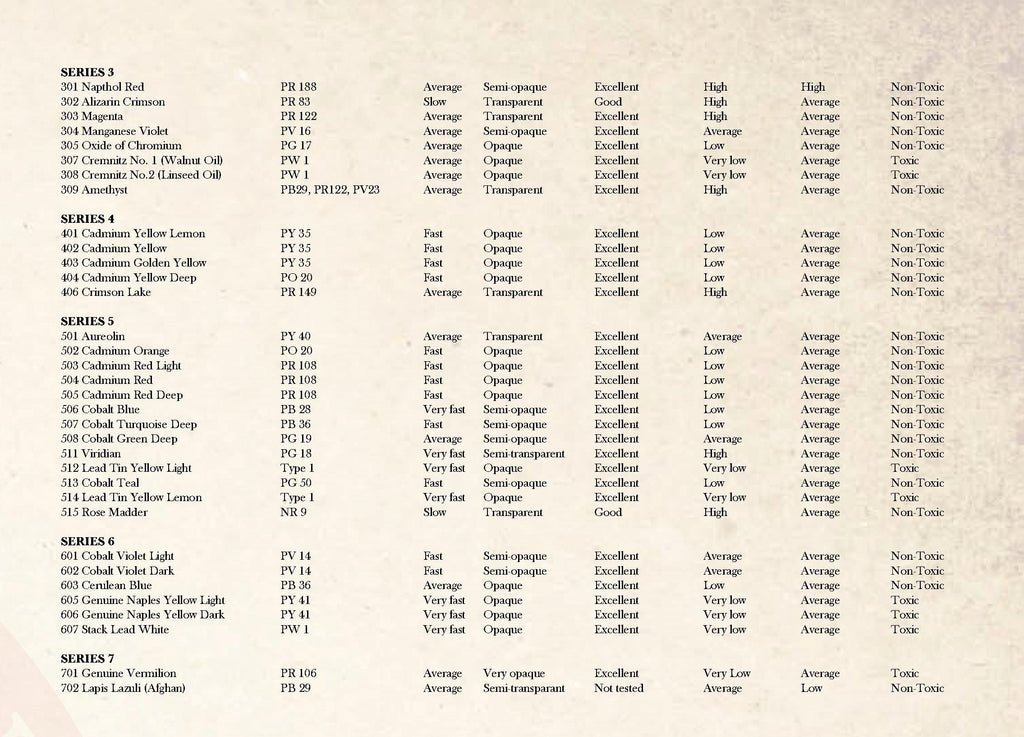Michael Harding Hand Made Oil Paints, explanation of Colour descriptions
Posted by Jeff Rowley on
In this article we explain the different headings in the below list of paint colours as taken from the PDF Product Guide and Colour Chart produced by top quality handmade oil paint manufacturer Michael Harding.


Series Number
Michael Harding paints are put into price series, the more expensive the ingredients (typically pigments) used then the higher the price and because the paints use very little fillers but instead mostly pure pigment then the quality is reflected in the price.
The Colour Index Number:
The Colour Index™ is a standardised system for recording the chemical composition of a dye or pigment . This external link (please note we are not responsible for information provided by external sources) usefully lists out all of the CI references used and their details
Estimated Drying Speed:
Temperature, humidity, light levels and film thickness (the thicker it is, the longer it will take) all affects drying speeds, so bear this in mind in regards to the advised drying times, the guidance is based on average factors.
The guide goes from 'Very Fast' for example the Umbers, many of which if used on their own, that is to say unmixed with other colours, will be touch dry within a warm summer day, to the 'Very Slow', which in an unmixed state, might take up to a week to cure.
Transparency:
Transparency is measured by the colours ability to cover the substrate it has been painted onto, with Cadmium's being most opaque and Indian Yellows the least.
Lightfastness:
Michael Harding uses descriptions for this, although there is an accepted numbered measurement of Lightfastness through the American Society of Testing and Manufactures (ASTM I-V) this tends to indicate the permanence of the core pigments without taking into account how they are concentrated in the paint mix, so for example a lightfast pigment was used with a lot of filler then it wouldn't be as permanent as if used in its concentrated form. Michael Harding paints pride themselves on using almost pure pigment with little or no filler used.
Tint Power
Tint Power (sheer strength of colour) shouldn't be confused with Transparency, some transparent paints, for example the Phthalo Lakes, are still terrifically strong even when mixed with very opaque hues.
Oil Content:
This generally reflects how much oil has been used to be ground in with the lake dye or dry pigment to make it into a workable paint.
As a general rule of thumb (though not always) Paint with high oil content dries to a glossier surface while conversely paints with low oil content will be leaner and tend to be not as glossy.
Toxicity:
While the information in the above chart is written simply in the way it indicates paints are toxic or non-toxic, there is a little more to it.
As a general precaution, do not allow paint into contact with your skin in such a volume that might cause skin sensitivity. There are also possibilities that some toxic pigments might be able to enter through the skin when used in conjunction with solvents.
Linseed and Poppy Oil are not considered toxic, however self-combustion (slowly igniting into fire) is possible particularly when on or in rags, so always dispose of with care by soaking in water first.
Lead, which is in Flake White / Foundation White / Cremnitz White can kill or harm an unborn child, even immediately after conception, so if in any doubt avoid contact. Lead is also known to be toxic for children and adults.
-
Keep these products away from children, even if part of a dry, finished painting.
-
Do not eat or smoke while working with these paints.
-
Do not allow dust to be inhaled, for example if sanding the surfaces containing these or any paints.
The alternatives to lead based colours use Zinc Oxide and Titanium Dioxide.
Lemon Yellow must also be treated in the same way to lead based paints as it contains Chrome and Barium; both harmful substances that cause a lot of other problems. There are several Lake Yellows which can be substituted instead by mixing with Titanium White.
Cadmium Colours are not officially subject to the same regulations covering lead-based products, but should also be treated with respect, if burnt for example cadmium is released in a form which is highly toxic.
Always wash hands well after use and before eating. Make sure your work space is well ventilated.
Michael Harding are pleased to offer further advice on their if you require it.



